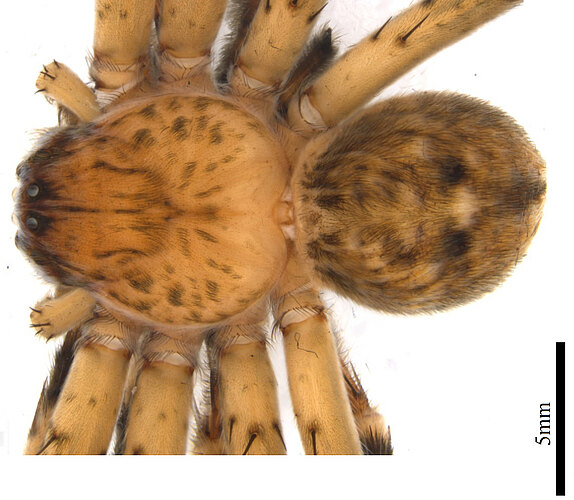Huntsman Spider Neosparassus FP-318 ('baehrae')
Fauna Portal species: 318Diagnosis
(by J. Schubert): The male of Neosparassus FP-318 can be distinguished from all other described Neosparassus species by the following combination of characters: ventral opisthosomal badge-marking large, black fading to reddish brown and triangular, tapering posteriorly and bordered posteriorly by two white tracts; sternum marked with broad, black X-shape; carapace longer than wide; retrolateral tibial apophysis (RTA) of pedipalp long, broad, and flat with a pointed apex; dorsal ridge of RTA broad and rounded, situated at basal surface of RTA; embolar base with one distinct denticle. Neosparassus FP-318 most closely resembles N. calligaster by the similarities in ventral opisthosomal badge markings and general morphology of the habitus, however, can readily be separated by the broad and flattened RTA (vs sickle-shaped in N. calligaster) and ~5 embolar coils (vs 2–3 in N. calligaster).
Fauna Portal Reference
Australia
- Western Australia
Fauna Portal Records
The map shows all records that have been verified as part of the Fauna Portal project and may not represent the true distribution of a species. Specifically, for described species, check the link to the Atlas of Living Australia on this page for potential wider distributions. Fauna Portal Reference specimens and Linnean types are shown in red. If you identified a specimen that exceeds the distribution of an undescribed species as illustrated here, please contact the Fauna Portal team who can assist with the lodgement of the specimen in a public institution and display on the map.
CATAAAGATATTGGAACTTTATATTTAATTTTTGGTGTGTGGGCTGCTATAGTTGGAACTGCAATAAGAGTGTTGATTCGCGCTGAGTTGGGACAGGTTGGAAGATTGTTTGGAGATGATCATTTATATAATGTTATTGTAACTGCTCATGCTTTTGTTATAATTTTTTTTATAGTTATACCTATTATAATTGGAGGATTTGGAAATTGATTGGTTCCATTAATATTAGGAGCTCCTGATATGGCTTTTCCTCGAATAAATAATTTAAGCTTTTGACTTTTACCTCCTTCTTTATTATTATTATTTGTTTCCTCAATAGTTGAAATAGGAGTAGGGGCAGGGTGAACTGTGTATCCTCCATTGGCGTCATCTATAGGTCATGCTGGAAGTTCTGTGGATTTTGCTATTTTTTCATTACATTTAGCTGGAGCTTCTTCTATTATAGGGGCTATTAATTTTATTTCTACTATTATTAATATACGTTCCCCTGGTAT-AAGAATGGAAAAGGTATCTTTATTTGTTTGATCTGTTTTAATTACAGCAATTTTATTGCTATTGTCTTTACCTGTATTAGCAGGTGCTATTACAATATTATTGACTGATCGAAATTTTAACACATCGTTTTTTGATCCTGCAGGAGGAGGAGATCCTGTGTTATTTCAGCATTTGTTTTGATTTTTTGGTCAC
Araneae (Spiders)
- Actinopodidae
- Anamidae
- Araneae fam. indet.
- Araneidae
- Archaeidae
- Argyronetidae
- Arkyidae
- Barychelidae
- Cheiracanthiidae
- Clubionidae
- Corinnidae
- Cycloctenidae
- Deinopidae
- Desidae
- Dictynidae
- Filistatidae
- Gnaphosidae
- Halonoproctidae
- Hersiliidae
- Idiopidae
- Lamponidae
- Linyphiidae
- Lycosidae
- Mimetidae
- Miturgidae
- Mysmenidae
- Nicodamidae
- Oecobiidae
- Oonopidae
- Oxyopidae
- Philodromidae
- Pholcidae
- Pisauridae
- Prodidomidae
- Salticidae
- Scytodidae
- Segestriidae
- Selenopidae
- Sparassidae
- Symphytognathidae
- Tetrablemmidae
- Tetragnathidae
- Theridiidae
- Thomisidae
- Trachelidae
- Trachycosmidae
- Trochanteriidae
- Uloboridae
- Zodariidae
- Zoropsidae
All classes
- Arachnida
- Crustacea
- Entognatha
- Gastropoda
- Insecta
- Orthoptera - Caelifera (Grasshoppers)
- Hymenoptera excl. Formicidae (bees and wasps)
- Blattodea s. str. (Cockroaches)
- Coleoptera (Beetles)
- Dermaptera (earwigs)
- Diptera (flies, mosquitos)
- Entomobryomorpha (slender springtails)
- Hemiptera - Heteroptera (True Bugs)
- Hemiptera - Sternorrhyncha (aphids, scales etc.)
- Hemiptera - Auchenorrhyncha (cicadas, planthoppers)
- Hymenoptera - Formicidae (Ants)
- Trichoptera (Caddisflies)
- Zygentoma (silverfish)
- Myriapoda

